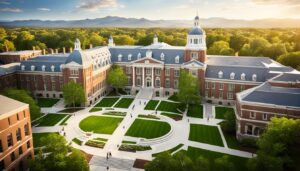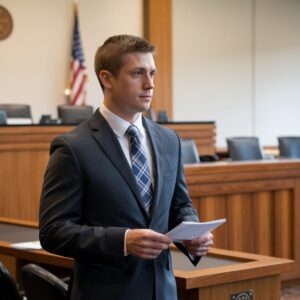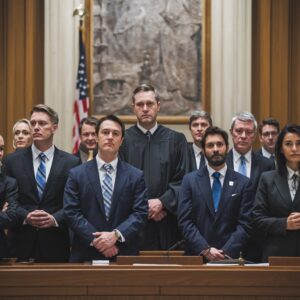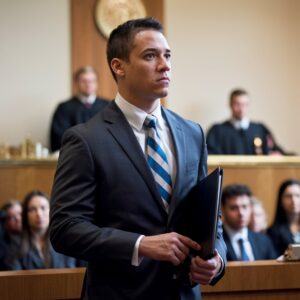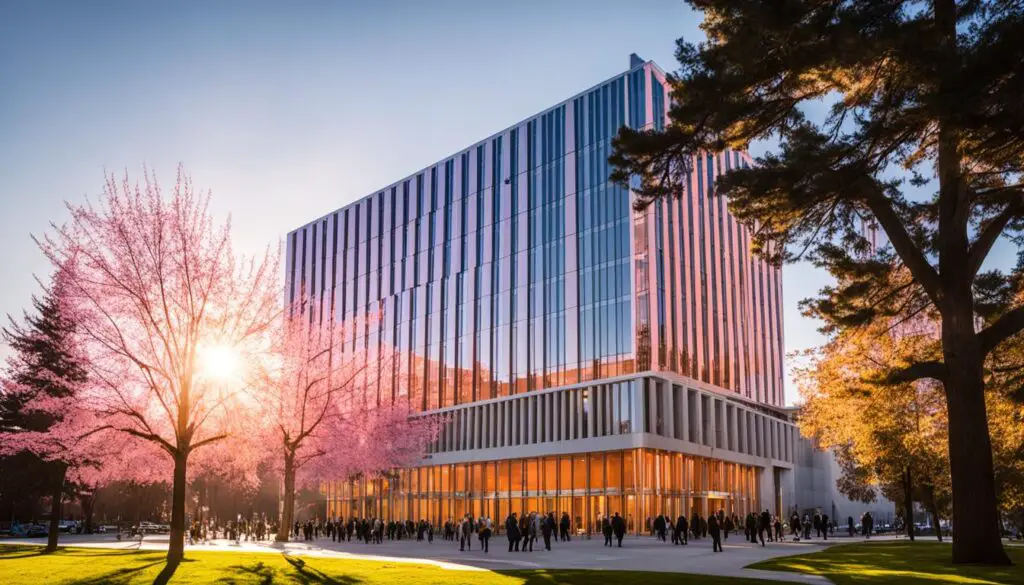
Greetings! I’m here to take you on a journey through the Wiley Manuel Courthouse in Oakland, a true legal landmark in the city. Situated in the heart of downtown Oakland, this courthouse stands as the focal point for a myriad of legal proceedings and services, catering to the needs of the community. Its significance is second to none, having been the venue for numerous high-profile cases that have grabbed headlines throughout the years.
The Wiley Manuel Courthouse derives its name from a trailblazer in the legal realm, Wiley W. Manuel. He was the first African American to serve as an associate justice of the California Supreme Court, leaving an indelible mark on the state’s legal history. Now, let’s delve deeper into the history and significance of this iconic building.
Key Takeaways:
- The Wiley Manuel Courthouse in Oakland is an esteemed legal landmark, located in the heart of downtown.
- Named after Wiley W. Manuel, the first African American associate justice of the California Supreme Court, it holds immense historical and cultural significance.
- The courthouse has been witness to countless high-profile cases, becoming a symbol of justice and law in the city.
- It offers a wide range of services, including courtrooms for civil and criminal cases, self-help centers, and mediation programs.
- The Wiley Manuel Courthouse plays a vital role in ensuring fair and accessible justice for the Oakland community.
History and Significance of the Wiley Manuel Courthouse
The Wiley Manuel Courthouse in Oakland has a remarkable history that underscores its significance in the city. Constructed in the early 1900s, this iconic courthouse has been a central pillar of the local legal system for over a century. It has witnessed countless trials and hearings, leaving a lasting impact on the course of justice in Oakland.
The Wiley Manuel Courthouse stands as a symbol of law and order, representing the city’s unwavering commitment to upholding justice and ensuring access to legal services for its residents. This historic landmark has not only served as a venue for legal proceedings, but it has also played an integral role in shaping the social fabric of Oakland.
“The Wiley Manuel Courthouse stands as a testament to the city’s dedication to justice and equality,” says John Davis, a local historian. “It has been a beacon of hope for the community, providing a platform for the pursuit of truth and fairness.”
This grand courthouse has become ingrained in the collective memory of Oakland, serving as a reminder of the city’s past and its ongoing commitment to the principles of justice. It has witnessed landmark cases that have shaped legal precedents in the region and remains an essential institution within the local legal landscape.
The Legacy Unveiled
The significance of the Wiley Manuel Courthouse reaches far beyond its function as a legal center. It stands as a testament to Oakland’s rich cultural heritage and its unwavering pursuit of justice. The courthouse’s architecture, with its imposing facade and ornate details, reflects the grandeur and importance of the institution it houses.
Today, the Wiley Manuel Courthouse continues to play a vital role in the lives of Oakland residents. It serves as a symbol of the city’s commitment to providing equitable access to justice and upholding the rule of law. As a center for legal proceedings, the courthouse remains a place where citizens can seek resolution, protection, and redress.
With its historical significance and ongoing relevance, the Wiley Manuel Courthouse stands tall as an enduring testament to the diverse and dynamic city of Oakland.
Services Offered at the Wiley Manuel Courthouse
The Wiley Manuel Courthouse in Oakland provides a wide range of essential services to the community. As a central hub for legal proceedings, the courthouse houses multiple courtrooms where civil and criminal cases are heard. This ensures that justice is served, and fair outcomes are achieved for all parties involved.
In addition to the courtrooms, the Wiley Manuel Courthouse offers access to valuable legal resources. Self-help centers are available to assist individuals with legal matters, providing them with information and guidance. These centers are designed to empower and support individuals navigating the complexities of the legal system.
Recognizing the importance of alternative dispute resolution, the Wiley Manuel Courthouse also offers mediation and dispute resolution programs. These services provide parties involved in legal disputes with an opportunity to find mutually agreeable solutions and avoid lengthy court proceedings. Mediation and dispute resolution offer a more collaborative and efficient approach to resolving conflicts.
The Wiley Manuel Courthouse stands as a vital institution in Oakland’s legal landscape. It plays a significant role in upholding justice and serving the community. By offering various services, from courtrooms to legal resources and support programs, the courthouse serves as a pillar of justice, ensuring equal access to the legal system for all residents of Oakland.
FAQ
What is the Wiley Manuel Courthouse?
The Wiley Manuel Courthouse is a legal landmark located in downtown Oakland. It serves as the central hub for various legal proceedings and services in the city.
Who is Wiley W. Manuel?
Wiley W. Manuel was the first African American to serve as an Associate Justice of the California Supreme Court. The courthouse is named after him to honor his contributions to the legal system.
What is the history of the Wiley Manuel Courthouse?
The courthouse was built in the early 1900s and has played a central role in Oakland’s legal system ever since. It has witnessed numerous trials and hearings, shaping the course of justice in the city.
What services are offered at the Wiley Manuel Courthouse?
The courthouse houses various courtrooms where civil and criminal cases are tried, ensuring fair and just outcomes. It also provides access to legal resources, self-help centers, and support services like mediation and dispute resolution programs.
Source Links
- https://deal.town/the-mercury-news/man-convicted-of-kidnapping-denise-huskins-faces-court-ordered-restitution-FKJFJYPTH4
- https://deal.town/the-mercury-news/all-of-the-remaining-prosecutors-alameda-district-attorney-pamela-price-put-on-leave-a-year-ago-are-now-back-PKFPD7F7E
- https://www.timesheraldonline.com/2024/01/27/oakland-armed-robbery-suspect-slips-out-of-court-hearing-disables-ankle-monitor-and-is-on-the-run-police-say/

